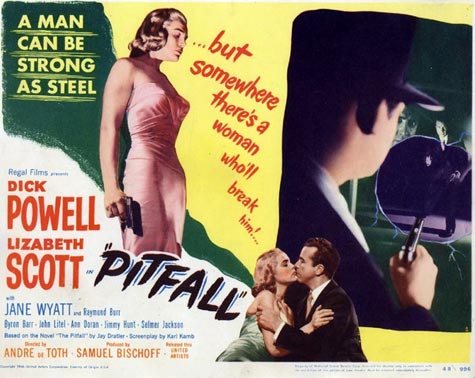
PITFALL André de Toth’s film teems with electric dialogue and potent real-life details. |
| “Unseen Noir” | Harvard Film Archive: May 23-26 |
Welcome to the dark territories again, the republic of bitterness and bile known as noir, as we square our jaws against an amoral universe and roam the rain-wet, lightless American City as if it were a Circle of the Inferno, where backstabbers, goldbrickers, and unfortunates march in closed patterns and puzzle over their fate. What can noir mean to us now? It’s not quite as easy to moon over the existential remarkability of the genre as it once was, when critics like Raymond Durgnat and Paul Schrader were busy specimen-boxing it as if it were a breed of black butterfly that had lived on our streets long ago and yet escaped our notice. Nowadays we’re somewhere near post-retro-neo-meta-noir; the original tropes (visual, gestural, thematic) are no longer recyclable even as TV commercials, and the Jim Thompson–rediscovery school is garnering yawns on the straight-to-video indie shelf. Sin City — please.But the beauty of noir has always been its cultural specificity — the genre is bound wrist and ankle to the unexpected, untamable social malaise that arose during WW2 and exploded in the post-war era. The films are modern anthropology, as wickedly expressive of its context and anxious historical moment as Goya’s aquatints or Faulkner’s novels or Walker Evans’s photographs — but emanating from a kind of American-pulp unconscious, not from the conscientious perspective of a single artist. Suspicion and dread were in the air. As such, the original noirs are timelessly pertinent, and they remain the most resonant school of movie to have emerged in America. Consider that a half-century or more after the fact, the then-disregarded classics of the genre sit high on our trophy shelves and our archival-DVD rosters while the huge, big-budget hits of the ’45-’60 period — think Forever Amber (1947), Jolson Sings Again (1949), The Greatest Show on Earth (1952), The Robe (1953), White Christmas (1954), Guys and Dolls (1956), Around the World in 80 Days (1957), etc. — are forgotten like the blundering, uninsightful junk they were. Against the odds, film noir just does not get old.

The “Unseen Noir” series — five double bills — screening at the Harvard Film Archive this weekend offers up lesser-known films that, though they may not be exactly unseen, are rarely remembered and discussed among noiristes. And none of them is available on video. It doesn’t matter: no individual noir is as important or telling as the genre’s DNA. Jacques Tourneur’s NIGHTFALL (1957; May 24 at 7 pm, with My Name Is Julia Ross) is a terrific, raw example — shot fast on cheap sets with the punchy jitters of a punk record, and focusing on a swollen, shamefaced Aldo Ray as a proverbial man on the run, with a bloody backstory that’s teased out of him by straight-shooting insurance investigator James Gregory (a fabulous and unsung character beacon of the post-war years, his noir roles leading up to his spectacular turns in Beneath the Planet of the Apes and Barney Miller), and hyper-wary alone-in-a-bar hottie Anne Bancroft. “Guys have probably been swarming around you ever since your second teeth came through,” Ray rasps at her (probably a line straight from the David Goodis novel), but soon enough the thugs come out of the shadows, and that leads to, among other extreme thoughts, a torture scenario using the inexorable machinery of an oil-field rig. You can imagine, for all its harried cheapness, why the movie’s been neglected (at least by comparison with Tourneur’s Out of the Past), but the relentless state of bottled-up anxiety insists that you contemplate the dark heart of the ’50s all over again.
André de Toth’s PITFALL (1948; May 25 at 7 pm, with Felix Feist’s Tomorrow Is Another Day) skirts the basic template of noir and comes close to being the first incarnation of the Fatal Attraction paradigm. Bored insurance exec Dick Powell puts his suburban family, home, and life in jeopardy after meeting lonely model Lizabeth Scott on a job, falling for her (after a classic fuck fade), and incurring the jealous thunderstorm of mountainous private dick Raymond Burr. De Toth was a drone, and the film lacks the vision that makes noirs sing, but it’s teeming with electric dialogue and potent real-life details (as when Powell and wife Jane Wyatt matter-of-factly change their boy’s sweat-saturated pajamas after a nightmare). Irving Reis’s shadowy, dreamlike CRACK-UP (1946; May 25 at 3 pm, with Boris Ingster’s Stranger on the Third Floor) isn’t thin — Pat O’Brien is an art expert who may or may not have amnesia, the sussing out of which reveals a harebrained conspiracy plot centered on a city museum — but the knotted narrative and the duplicitous characters obscure the film’s essential noirness, making it more sub-Hitchcockian than authentically desperate.